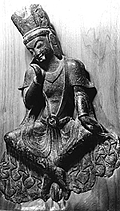

Museum-goers who visit the Allen Art Museum sometime this semester will inevitably be drawn to a new exhibit in the Goblet Room entitled "Revelations of the Dharma: Buddhist Art from the Permanent Collection". This exhibit, organized by Asian Art Curator Charles Mason, draws attention to itself in a quiet, peaceful way and invites the viewer to learn about Buddhism while soaking in the beauty the religion has inspired.
A large black limestone sculpture of Buddha from 6th century China stands outside the exhibit as if to welcome visitors. In this way, the Buddhist votive stele is performing its original function of attracting worshippers to Temple. Mason said that keeping the stele outside the exhibit space also had practical implications in that it "avoided the problem of dragging it in."
The fact that Buddhist art is full of symbolism is well-documented in this exhibit and is also true of the Buddhist votive stele sculpture. The lotus flower on which the Buddha is standing grows out of swamp land and represents the transcendence of good over evil. The Buddha's handshapes, known as mudras, are his way of communicating his willingness to help his followers and calm their fears.
Once inside the exhibit space, viewers notice the dim lighting, warm mahogany paneling and vibrant purple, velvet curtains. All of these details add to the atmosphere in which the Buddhist images are exhibited. Mason said he "wanted [the exhibit] to have an almost temple-like feel" so he closed two of the three doors leading into the room.
As the viewer walks into "Revelations", he/she is confronted by a gilt bronze sculpture of Buddha's upturned hand in the middle of the room. According to Mason it was probably part of a complete sculpture of Buddha at some point. Mason said that he positioned this piece in the middle of the room because he wanted the exhibit to have a focal point. Unlike the large limestone stele which leads visitors into the exhibit, the Thai "Hand of the Buddha" slows the viewer and through the Buddha's halting gesture, serves to remind people not to touch the works of art.
Many of the pieces in the exhibit are rarely or never on display at the museum. The reason for this is that some of the pieces are not in good condition and some are light sensitive, as in the case of the hanging scrolls. Also, there is no permanent Asian art gallery in the museum. Consequently, almost all of the Buddhist art in the museum has come out of storage for this show.
Although the limestone reliefs and sculpture have lost their brightly painted, original designs, one of the wooden sculptures has been partially eaten away by worms, and the scrolls are faded, the mere possibility of their display reveals that they have been treasured and cared for in the past. For example, Mason said the Buddhist votive stele has probably survived until now because it was buried underground for protection during the Buddhist persecutions in 845 in China. "You can see traces of encrustation. [That's] probably helped its survival throughout the years," he said.
The fact that Buddhist art was created out of spiritual calling rather than for personal expression is evident in examining the pieces on display. For the most part, the works are unsigned. It is also interesting to note that despite the fact that the works were made in many different countries and by people of many different cultures, the images have many commonalities as, according to Mason, "there is an international Buddhist style."
Mason referred to the 19th century domestic shrine which portrays the healing Buddha, the historical Buddha and the Buddha of infinite light while speaking about the endurance and everyday presence of Buddhist spirituality. It is amazing that some sculpture was made to be contained within larger sculpture, never intended to be seen by museum viewers or Buddhist worshippers. The 6th century Chinese "Seated Bodhisattva" and 13th century Cambodian "Dancing Aspara" were "hacked out of abandoned temples," said Mason, "it is distorting to view them [in this way] because they would have originally been part of a larger context."
Mason chose the exhibit's title, "Revelations of the Dharma..." because the show is meant to teach people about Buddhist imagery and religion. According to Mason, curators at the Allen Museum are "trying to have more exhibitions related to course offerings." The timing for this exhibit was set to coincide with two Spring courses dealing with Buddhist iconography; Japanese Thought and Religion with Professor Dobbins and Buddhist Art with Sarah Thompson.
Ancient art: A seated Boghisattva from the AMAM exhibit. (photo courtesy of the Allen Memorial Art Museum)
Copyright © 1998, The Oberlin Review.
Volume 126, Number 16, February 27, 1998
Contact us with your comments and suggestions.